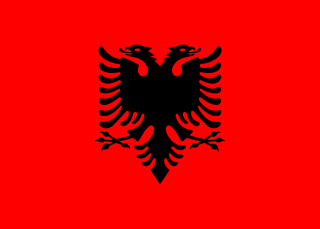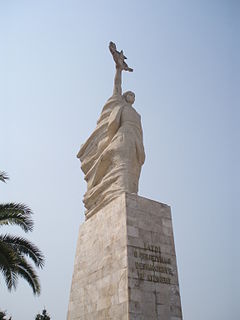 W
WSkanderbeg was a prominent figure in the history of Albania. His weapons have been subjects of mythical adoration. According to legends, his sword was so heavy that only his arm could wield it. It was also said to be so sharp that it could slice a man vertically from head to waist with little effort and cut a huge boulder in half with a single blow.
 W
WThe Coat of arms of Albania is an adaptation of the Flag of Albania which is based on the flag and seal of Gjergj Kastrioti Skanderbeg. The helmet above the head of the two-headed eagle is the helmet of Skanderbeg, surmounted with billy goat's horns.
 W
WIn heraldry and vexillology, the double-headed eagle is a charge associated with the concept of Empire. Most modern uses of the symbol are directly or indirectly associated with its use by the Byzantine Empire, whose use of it represented the Empire's dominion over the Near East and the West. The symbol is much older, and its original meaning is debated among scholars. The eagle has long been a symbol of power and dominion.
 W
WThe flag of Albania is a red flag with a silhouetted black double-headed eagle in the center. The red stands for bravery, strength, valour and bloodshed, while the double-headed eagle represents the sovereign state of Albania. The flag was established as the national flag of Albania when the country gained its independence from the Ottoman empire in 1912.
 W
WFustanella is a traditional pleated skirt-like garment that is also referred to as a kilt worn by men of many nations in the Balkans. In modern times, the fustanella is part of Balkan folk dresses. In Greece, a short version of the fustanella is worn by ceremonial military units such as the Evzones, while in Albania it was worn by the Royal Guard in the interbellum era. Both Greece and Albania claim the fustanella as a national costume. Additionally Aromanians claim the fustanella as their ethnic costume.
 W
W"Himni i Flamurit" is the national anthem of Albania, adopted in 1912.
 W
WThe Monument of Independence is a monument in Vlorë, Albania, dedicated to the Albanian Declaration of Independence and worked by Albanian sculptors, Muntaz Dhrami and Kristaq Rama. It is found in the Flag's Plaza, near the building where the first Albanian government worked in 1913.
 W
WMother Albania is a 12 m statue located at the National Martyrs Cemetery of Albania in Albania, dedicated in 1971.
 W
WThe National History Museum is a historical museum in Tirana, Albania. It was opened on 28 October 1981 and is 27,000 square metres in size, while 18,000 square metres are available for expositions.
 W
WThe Skanderbeg Monument is a monument in the Skanderbeg Square in Tirana, Albania. It commemorates Skanderbeg, the national hero in Albania for resisting the Ottomans.
 W
WThe griffon vulture is a large Old World vulture in the bird of prey family Accipitridae. It is also known as the Eurasian griffon. It is not to be confused with a different species, Rüppell's griffon vulture. It is closely related to the white-backed vulture.